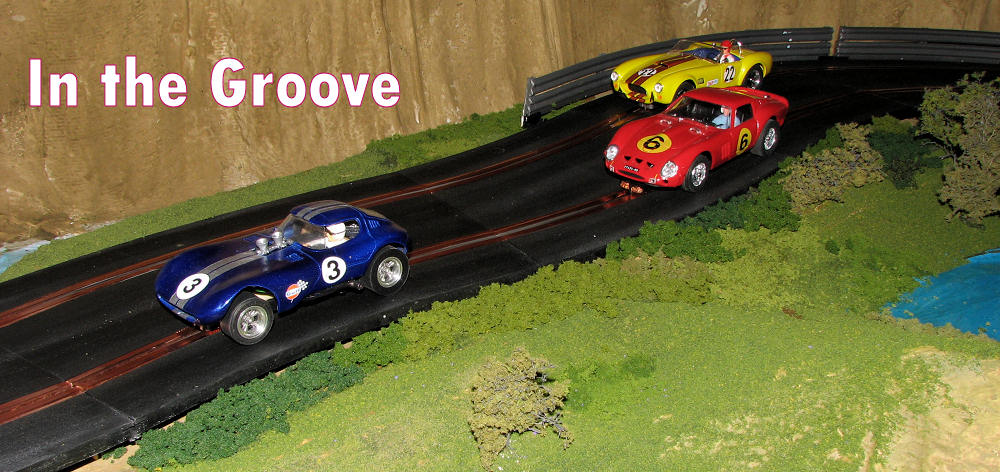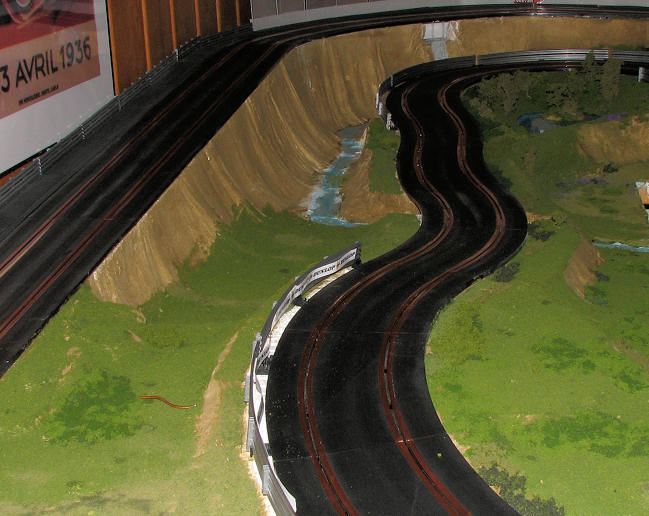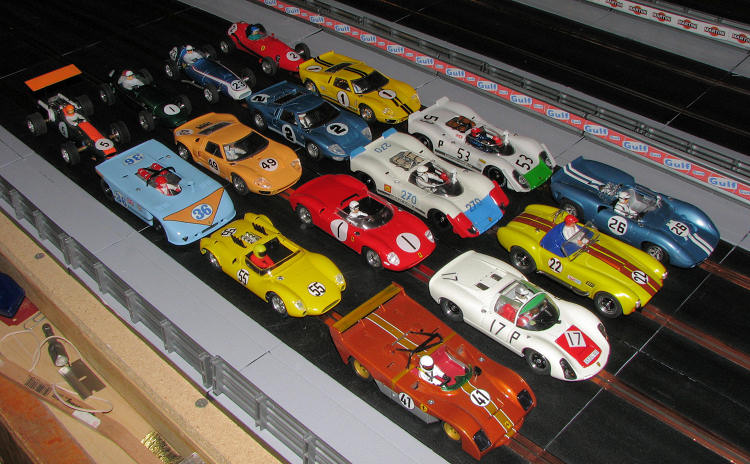

As you can see from the main photo, work slowly continues with adding scenery to the track. By using various shades and consistency of materials, you can really get a very interesting look of things. As mentioned last time, this is something where I add a small bit at a time, usually taking no more than 15 minutes or so each day or so. As time goes on, it slowly develops.
 When doing
things like this, I start with the finer materials and work up to the coarser
ones. Using regular white glue, the items are secured and when dry, I use
water-consistency white glue to help hold some of the loose stuff more securely.
If a car should happen to exit the track and get into this material, it is best
to keep the stuff out of the running gear. That is also why I vacuum the newly
done areas after the glue has dried. It is a bit wasteful of material, but one
plans for that. As you can see, there are several places where the white of the
styrofoam is showing, with no cover on them that still need to be done
When doing
things like this, I start with the finer materials and work up to the coarser
ones. Using regular white glue, the items are secured and when dry, I use
water-consistency white glue to help hold some of the loose stuff more securely.
If a car should happen to exit the track and get into this material, it is best
to keep the stuff out of the running gear. That is also why I vacuum the newly
done areas after the glue has dried. It is a bit wasteful of material, but one
plans for that. As you can see, there are several places where the white of the
styrofoam is showing, with no cover on them that still need to be done
The header image is taken at the center of this particular photo near the top. As you can see, things are going along quite nicely and you get a better idea of how the area in the 'gorge' looks. I'll eventually get some bits of vegetation in there, but not until most of the rest has been done. In scale, the deepest part of the gorge near the waterfall isn't really more than 20 feet, but it does provide some interest.
Besides fiddling with the track, over the last several months I have been buying and building a few kits, rehabbing some basket case cars that I got on the cheap, and doing a few repaints. It is much more interesting to me to have something that 5,000 or 6,000 other people do not have. Like with model kits, the standard run of these cars is about that many. Unlike model kits, these are not reissued in exactly the same livery. The hobby base is smaller so doing that many of one livery is really quite a lot.
Anyway, I thoroughly enjoy the work that goes into one of the rehabs or repaints. It generally takes several weeks to well over a month to do one from start to finish, but like my lethargic model kit building, doing a little bit at a time will eventually get things done. These don't just sit on the shelf to be admired, but get run quite frequently. If you look at the header image, the blue car, a Cheetah, is a resin kit that provides the body and chassis with everything else coming from somewhere else. The yellow Cobra is a repaint where the body has all the bits removed, is stripped of paint and then redone. The Ferrari is a RTR.
If you look at the photo below, you can see all that I've done
since about January. The cars in the last row are kits or are
 scratchbuilt.
The three Forumula one kits are shown on the header of the last installment. The
blue and orange car was built with a vacuformed body and the chassis
scratch-built from brass plate and tubing.
scratchbuilt.
The three Forumula one kits are shown on the header of the last installment. The
blue and orange car was built with a vacuformed body and the chassis
scratch-built from brass plate and tubing.
Some of the rest are simple repaints, while others are minor modifications and a few others are total rebuilds from 'junk' parts. While I try to make the cars as historically accurate as I can, every once in a while I like to do a custom paint scheme, like the #41 car in the forefront and the #22 Cobra. Researching some of these is a real challenge as frequently there are not many photos of the car in question and even more times those photos are not in color. Good for placement of markings, but not so great for getting the correct shade of paint. As often happens, I put out a plea for information on various web sites, get nothing back and once I finish and show the result, I get the "oh, I have tons of photos of that car and you screwed up (fill in the blank). So Rivet Counters are everywhere.
In closing I'll answer a question I get asked rather frequently. Most cars are left hand drive. That way the driver is on the side of the car closest to the center of the road, which makes it safer for passing (Those in the UK and few other countries drive on the 'wrong' side of the road). With purpose built racing cars, it is nearly always right hand drive. Road racing courses are just about all clockwise in the way the races are run (there are exceptions) so having the driver on the right side is better for weight distribution in the predominately right hand corners on these tracks.
I hope you learned a bit and if you have any questions or wish to share your experiences or images of your track, I'd like to hear from you on the subject so please e-mail me at mmreaders@aol.com.
Scott